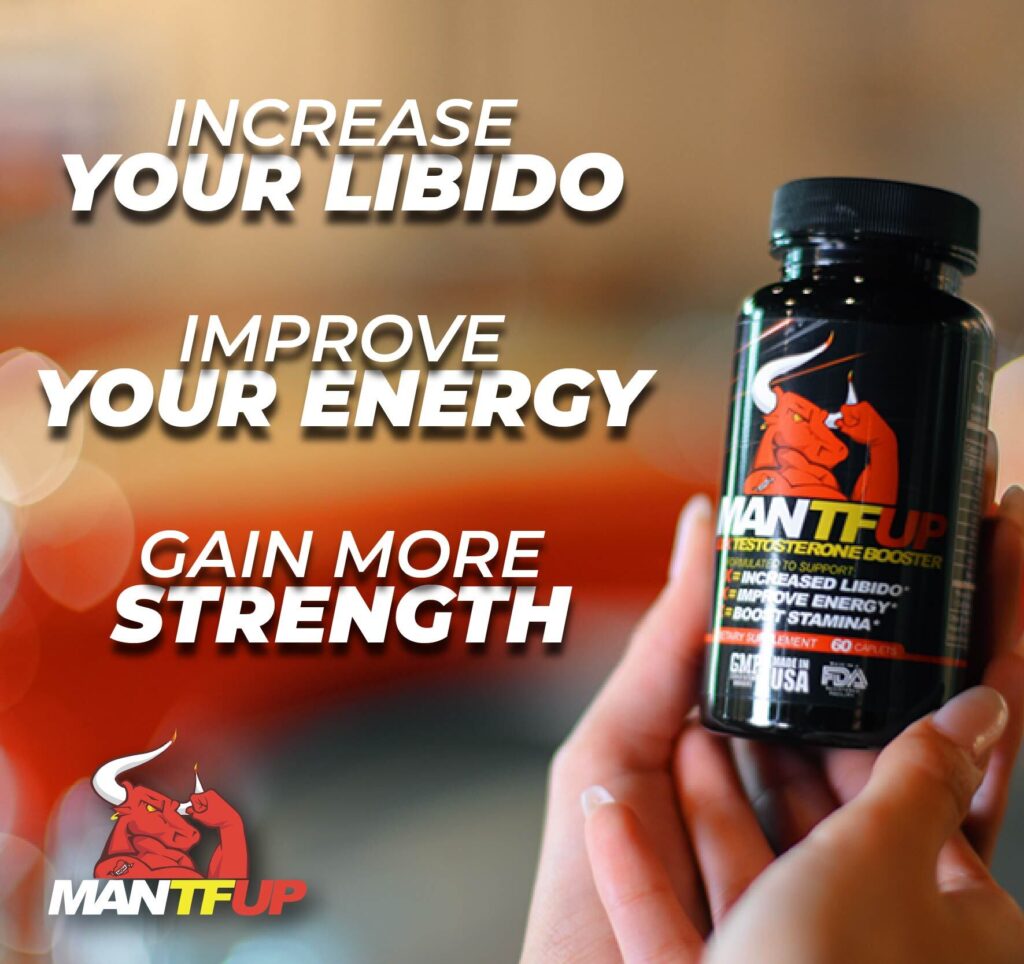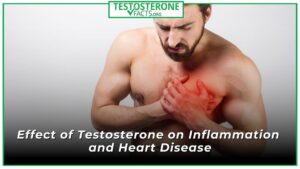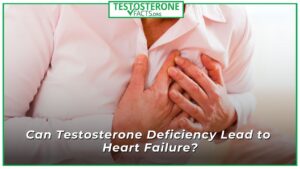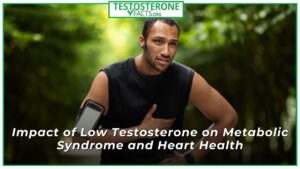
What’s Safer, Testosterone Or Steroids?
- TFacts Staff
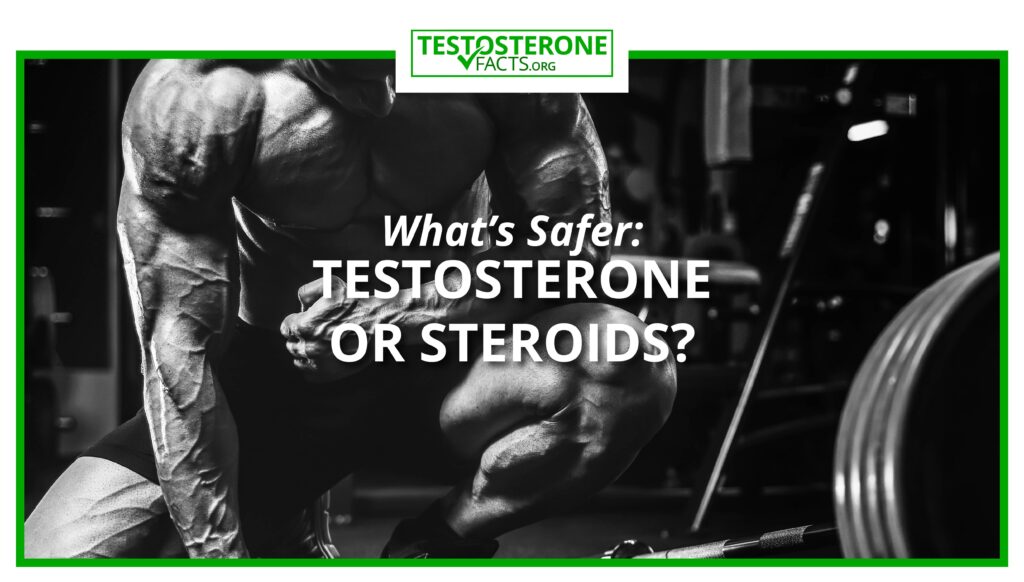
When people talk about using substances to improve their health or athletic performance, two main options often come up: testosterone therapy and anabolic steroids. Testosterone therapy is a medical treatment for those who don’t have enough testosterone. Anabolic steroids are similar but stronger, and people use them to build more muscle or perform better in sports. Both have their uses, but they also come with risks like side effects and legal issues. It’s important to know how they differ and what those risks are.
Let’s explore both options and find out which option you can opt for:
Table of Contents
ToggleOverview of hormones and steroids
Testosterone is a hormone that regulates male physical traits such as muscle mass and strength, fat distribution, and bone density. It also improves libido, mood regulation, and cognitive abilities. Men produce significantly more testosterone than women.
Anabolic-androgenic steroids (AAS) are synthetic versions of testosterone. They are intended to increase testosterone’s anabolic qualities (i.e., muscle-building benefits) while reducing androgenic effects (i.e., features that lead to male sexual attributes). AAS are used medically to address hormone shortages, muscle wasting illnesses, and certain kinds of anemia. They are better known for their application to improve sports performance and body in non-medical contexts.
Both testosterone and steroids interact with muscle cells and influence protein synthesis, which promotes muscular growth and recovery. They also impact body composition, bone density, and red blood cell formation, all contributing to overall physical performance. TRT and the medical usage of AAS have their roles in treating particular health issues. The choice to utilize these therapies should be made after carefully assessing the potential benefits and dangers. Let’s go through them.
Medical Use Of Testosterone Replacement Therapy
You must have often come across questions like, Are testosterone pills steroids? Technically, yes, but not in the way that most people understand. Testosterone Replacement Therapy (TRT) is usually prescribed to males who have low testosterone levels, also known as hypogonadism. This can cause weariness, decreased libido, physical weakness, and mood swings. TRT is meant to restore testosterone levels to normal ranges, hence reducing these symptoms.
TRT is not appropriate for everyone. It is normally prohibited in males who have specific types of cancer, such as prostate or breast cancer, because testosterone may encourage tumor growth. Other contraindications include severe sleep apnea, uncontrolled heart failure, and a high red blood cell count, which raises the risk of blood clots.
Benefits and Risks
For men with truly low testosterone levels, TRT can significantly enhance their quality of life. Enhanced muscle growth and strength, greater sexual function and libido, more energy, a better mood, and enhanced bone density are all advantages.
However, TRT, despite its benefits, is not without hazards. These can include an increased risk in cardiovascular system, such as heart attacks and strokes, particularly in elderly males. Other dangers include increasing sleep apnea, leading to enlarged prostate symptoms, and accelerating the progression of existing prostate cancer. TRT can also reduce sperm count, which affects fertility.
Medical Use Of Anabolic Steroids
Anabolic-androgenic steroids (AAS) have real medicinal purposes, including treating delayed puberty in boys, muscle loss caused by diseases like cancer and AIDS, and certain types of anemia. In these situations, AAS can help accelerate muscular growth and hunger, increase bone density, and boost red blood cell production.
However, AAS may have negative effects even when taken for valid medical purposes. These dangers grow with the amount and duration of steroid use. Side effects may include liver damage, raised cholesterol levels, an increased risk of cardiovascular disease, hormonal imbalances (such as gynecomastia, which is the growth of breast tissue in men), acne, and behavioral changes such as hostility and mood swings.
It is critical to distinguish between the controlled medical usage of AAS and their non-medical use or misuse. Non-medical usage of AAS, frequently at considerably greater doses for bodybuilding or performance enhancement, significantly raises the risk of side effects.
Non-Medical Use and Abuse of Testosterone and Steroids
Studies published by The Testosterone Centres in Texas have stated the difference between TRT and steroid use. However, non-medical use of both testosterone and anabolic-androgenic steroids (AAS) is common in settings where greater muscle growth and physical performance are highly valued, such as bodybuilding and competitive sports. Users frequently seek to go beyond the natural limits of muscle growth and strength gains offered by regular exercise and diet.
Side Effects
Cardiovascular Problems: Non-medical use of AAS can cause high blood pressure, heart attacks, and strokes. These dangers are exacerbated by the fact that steroids can raise LDL (“bad”) cholesterol while lowering HDL (“good”) cholesterol.
Liver Damage: Oral anabolic steroids can be especially detrimental to the liver, causing illnesses including hepatitis and liver tumors. Even injectable steroids can be harmful to liver health over time.
Hormonal Imbalance: Excessive testosterone or AAS usage alters the body’s natural hormonal balance. In men, this can cause testicular atrophy, decreased sperm production, and gynecomastia (the formation of breast tissue). Women may experience masculinizing effects. Deepening of the voice, increased body hair, and changes in menstrual periods can be a few of them.
Musculoskeletal Risks: AAS, especially in teenagers, can cause premature closure of growth plates in the bones, resulting in limited growth.
Mood changes and hostility: Also known as “roid rage,” users may experience severe mood changes and increased hostility.
Depression and Anxiety: Steroid withdrawal can cause mood disorders such as depression and anxiety. These sometimes are aggravated by the cessation of physical improvement and performance gains.
Addiction: Psychological dependence on the effects of testosterone and AAS can lead to addiction, in which users find it difficult to quit, even knowing the negative consequences.
Withdrawal Symptoms: When you stop using steroids for an extended period, you may experience withdrawal symptoms. Fatigue, restlessness, loss of appetite, sleeplessness, decreased sexual drive, and steroid cravings are all possible symptoms. Depression is a particularly severe withdrawal syndrome that might lead to suicidal ideation or behavior.
Comparative Study between Testosterone and Steroids
Comparative studies of TRT and AAS use focus on the differences in safety and health outcomes depending on the intended use and administration doses. TRT strives to restore natural testosterone levels and is medically controlled, resulting in fewer and less severe adverse effects than AAS. AAS, which is largely utilized for muscular growth and athletic enhancement, frequently requires greater doses and can pose more serious health hazards.
Key findings:
- TRT offers a lower risk profile when provided and monitored properly, with the goal of reaching physiological testosterone levels.
- AAS usage, particularly at high doses for performance enhancement, is linked to a risk of cardiovascular disease, liver damage, and hormone abnormalities.
Short-term versus long-term risks
Short-Term Risks: TRT can cause acne, fluid retention, and mood fluctuations soon after it begins. AAS users may develop severe acne, liver problems, and violent behavior rather soon.
Long-term: TRT has been linked to an increased risk of prostate disorders, including cancer and polycythemia. Long-term AAS usage can cause heart disease, stroke, chronic liver disease, and psychological problems like depression and aggressiveness.
Age:
- Older men using TRT may have a higher risk of cardiovascular events.
- Young AAS users risk prematurely sealing their growth plates, resulting in stunted development.
Women:
- Women who use TRT for diseases such as breast cancer or menopausal symptoms may experience masculinization at high doses.
- Women who use AAS have a higher chance of virilization, which includes a deeper voice and more body hair.
Preexisting Conditions:
Individuals with pre-existing heart issues may have worsening symptoms with TRT or AAS.
Those with liver problems are more vulnerable to AAS, particularly oral forms that have been shown to be hepatotoxic.
The table below represents a clear and simple comparison of essential characteristics of testosterone therapy and anabolic steroids:
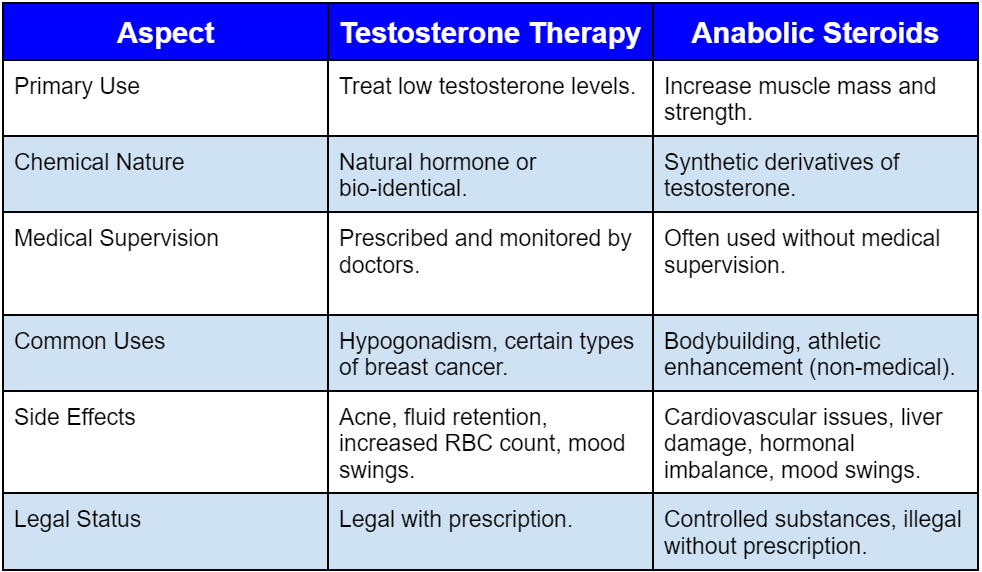
Alternatives to Steroid Use
Strength Training and Nutrition: Optimize your strength training routines and nutrition to promote muscle growth and sports performance without using AAS.
Supplements: Consider using legal supplements like protein powders, creatine, and branched-chain amino acids (BCAAs) to help with muscle growth and recuperation.
Medical alternatives:
SARMs and Peptides: Some may consider using selective androgen receptor modulators (SARMs) and peptides as alternatives. However, it is critical to understand their regulatory status and associated health hazards.
Conclusion:
While TRT and AAS carry dangers, the main distinction is the purpose of use and the level of medical monitoring required. TRT is medically monitored and aims to restore normal hormone levels while carrying a lower risk profile. Non-medical AAS usage, which frequently involves greater doses, is connected with serious health hazards, including life-threatening situations. Individuals choosing either therapy should contact healthcare specialists, examine the benefits and hazards, and consider the long-term effects on their health.

